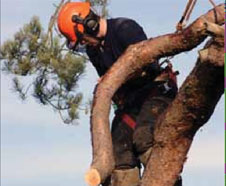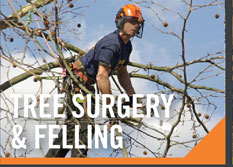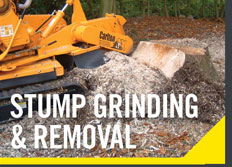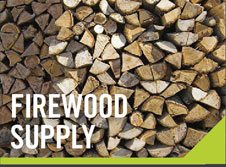FAQs
Tree Surgery FAQs
1) How should I choose a Tree Contractor?
2) What to expect from a written quote?
3) What are the running costs for Tree Contractors?
4) My trees are located within a Conservation Area or have a TPO on them. What do I do now?
5) How do I check if a tree is subject to a TPO?
Stump Grinding FAQs
1) How long does it take to remove a stump?
2) What size stumps are you capable of removing?
3) How much waste is created? and can you remove it?
4) I only have narrow access to my garden can you still remove the stump?
5) How much will it cost to remove a stump?
6) I have several stumps in my garden, do you charge per stump or per job?
7) Do you have the required insurance to carry out the work?
Firewood FAQs
1) So where does our firewood come from? And is it environmentally friendly?
Tree Surgery FAQs
1) How should I choose a tree contractor / tree surgeon?
To make sure your tree surgeon is qualified and skilled enough to carry out the works requested without causing irreversible damage to your trees, you should take the process of choosing one seriously. You should ask the tree contractor to come and inspect the work to be undertaken and provide a written quote. An ideal tree contractor would:
- Have Employers Liability and Public Liability Insurance
- Be knowledgeable about British Standard 3998, the latest research and good practice methods
- Have full safety training and equipment
- Have skills certificates such as NPTC
- Be able to provide testimonials and references with regards to previous tree surgery work
- Provide a written quotation with no obligation
2) What should I expect from a written quote?
A full description of the work to be undertaken
The total cost of the operation
Who will clear up the wood and chip removed from the trees
Who is responsible for obtaining legal permission eg. from your local council, if necessary?
How will the tree surgeon make sure your property and any public property are safe during the operation
3) What are the running costs for tree surgeons?
Tree Surgeons have a number of running costs which are built into the price of their services.
Legislative requirements
The legislative requirements below all relate to safety - for the tree surgeon, for you and for your property. It costs to remain up to date in these qualifications hence they are included in our running cost list.
• Health and Safety at Work Act (HSWA)
• Management Of Health And Safety At Work Regulations (MHSWR)
• Work at Height Regulations
• Provision And Use Of Work Equipment Regulations (PUWER)
• Lifting Operations And Lifting Equipment Regulations (LOLER)
• Personal Protective Equipment At Work Regulations (PPE)
• Manual Handling Operations Regulations
• The Control Of Substances Hazardous To Health Regulations (COSHH)
• Noise at Work Regulations
• Construction (Design And Management) Regulations (CDM)
• Electricity at Work Regulations
• The Electricity Safety, Quality and Continuity Regulations
Public Liability insurance
Covers up to £1 million, £2 million, £5 million or £10 million compensation(depending on the options taken out by your Tree Contractor) for any damages or legal costs you might be exposed to as a result of negligence on behalf of your Tree Contractor.
Employer Liability Insurance
Compulsory for every firm that employs people - this protects your Tree Contractor's employees against risks in the workplace and pays them compensation if they are injured at work as a result of the Tree Contractor's negligence. The minimum legal requirement is £5m of cover.
Professional Indemnity
This is to cover your Tree Contractor's legal liability for the advice and design that they provide, on the basis that this advice/design is given in a professional capacity. For example, Professional Indemnity would protect the Tree Contractor against defending a claim and any damages awarded for work at a standard that the client was unhappy with.
The Health and Safety at Work Act
Employers, the self-employed and employees have a duty to ensure the health, safety and welfare of persons at their place of work and for protection of other people who may be affected by the work activity. More specific sets of regulations covering various areas of of work activities eg. Tree Contracting all come under The Health and Safety at Work Act .
The Management of Health and Safety at Work Regulations
Your Tree Contractor must carry out risk assessments of each individual job to identify the measures necessary to comply with this health and safety legislation. Each risk assessment must cover any risk to the health and safety of employees, the self-employed and others who are not at work i.e. members of the public. After the risk assessment is made, appropriate arrangements for managing the work must be put in place and identified risks must be reduced to an acceptable level. Staff training in health and safety also comes under this regulation.
The Work at Height Regulations
This applies to all work – including tree surgeon work – at height where there is a risk of injury in the event of a fall. The Regulations set out arrangements required for the effective management of work at height. They cover selection, installation and use of work equipment and techniques for working at height. In addition to the general measures, tree climbing using a rope and harness has to meet specific requirements set out in Schedule 5, parts 1, 2 & 3 are relevant (depending on the work being done). Ladder use is covered in Schedule 6.
The Provision and Use of Work Equipment Regulations (PUWER)
All work equipment used in arboriculture and tree surgery, eg. ropes, harnesses, strops etc as well as machinery, must be carefully selected bearing in mind the location of the work to be done and the purpose for which it is to be used. Instruction, training and supervision of those using the work equipment is also set out.
There is a new Approved Code of Practice to the regulations which states that a recognised certificate of competence or a national competence award relevant to the work being done must be held by anyone using chainsaws in or on trees.
The Lifting Operations and Lifting Equipment Regulations (LOLER)
Lifting Equipment includes climber’s ropes, harnesses and other parts of the climbing system. The main aim of this Regulation is to ensure all lifting operations (including arboricultural operations) are properly planned, appropriately supervised and carried out in a safe manner. Matters such as strength, stability and installation must be addressed. In addition, equipment should be marked and thoroughly examined at prescribed intervals according to the terms of the Regulation. Suitable devices must be used to prevent the carrier (a term used to describe the means of holding the person, i.e. the harness) from falling. A competent person (i.e. the operator) must assess the main climbing rope and equipment every day. In addition, there are requirements under LOLER for:
• Written weekly record of inspection for equipment that is “subject to high levels of wear and tear”
• A competent person in authority who can make an independent objective decision will decide as to whether the equipment remains in use or not.
• Any equipment used for lifting people must be properly examined every 6 months.
• All other equipment, such as rigging equipment, needs to be thoroughly examined every 12 months.
HSE advice to tree surgeons for chainsaw & climbing operations
'AFAG', The health and safety commission Arboriculture and Forestry Advisory Group, aims to promote good practice and develop practical guidance for tree contractors by the use of an evidence-based approach.
Since April 2005, a number of research projects have been completed addressing a range of subject areas across the sector. The majority of this has been co-funded by The Health and Safety Executive (HSE) and the Forestry Commission (FC) and research has been assisted directly by the tree work industry. The resulting AFAG guidelines have since become best practice and should be adhered to by all tree contractors.
4) My trees are located within a Conservation Area - what do I do now?
Tree Preservation Orders can be in place for a number of reasons and on any species of tree. For example to avoid loss to biodiversity in the area or because the loss of the tree is simply deemed to be unnecessary. Your tree contractor's work might also be affected by legislation to protect bats or birds or to avoid damage to trees during installation of underground or overhead services. If a tree contractor contravenes any of these forms of legal protection they can incur heavy fines.
The Tree Preservation Order (TPO)
The Town and Country Planning Act 1947 established a the modern planning system, whereby local planning authorities could protect trees and woodlands by placing Tree Preservation Orders (TPOs). This system has been reinforced in 1990, 1999 and in 2008 by subsequent Town and Country Planning Acts.
Conservation Areas
In a conservation area, all trees over a certain size are protected. Six weeks notice of intent must be given to the local planning authority before work by a tree surgeon or other individual is carried out, except in specific circumstances eg. emergency work.
Protected trees are identified in number form from individual trees (T numbers), groups of trees (G numbers), all trees in an area (A numbers) and woodlands (W numbers). Each order prevents the cutting down, topping, lopping, uprooting, wilful damage or wilful destruction of trees, except in certain circumstances, other than with consent of the local planning authority. (The council) Even when no specific legal protection exists, it might be necessary to obtain a felling licence. A felling license is also required if the volume of timber to be felled exceeds specified amounts. The Forestry Commission England, the Forestry Commission Scotland and the Forestry Commission Wales administer this legislation, under the Forestry Act 1967 as amended.
Responsibility of the land owner before issuing instructions
Your local planning authority, usually referred to as the council, makes the TPOs in your area. A TPO makes it an offence to cut down, top, lop, uproot, wilfully damage or wilfully destroy a tree without the council’s permission. The idea is to protect any trees which have a significant impact on their local surroundings. Any type of tree can be covered by an order, including hedgerow trees (but not hedges, bushes or shrubs). An order can cover anything from a single tree to whole woodlands and a tree contractor will need to know about any orders in place before beginning a job.
Only in the following circumstances can a tree contractor work on a protected tree:
• where they are cutting down trees in accordance with one of the Forestry Commission’s grant schemes
• where the Forestry Commission England has granted a felling license
• immediate cutting down or cutting back a tree which is dying, dead, or dangerous
• in line with an obligation under an act of parliament
• at the request of certain organisations specified in the order
• felling a tree which is directly in the way of development that is about to start for which detailed planning permission has been granted
• working on trees in a commercial orchard, or pruning fruit trees in accordance with good horticultural practice
• to prevent or control a legal nuisance (your solicitor should be able to help you define 'legal nuisance')
If you are in any doubt, check with your council’s tree officer. Important: In undertaking any work believed to be covered by one of the above exemptions, the burden of proof lies with the landowner to confirm that the exemption previously existed. In addition, should your tree contractor not follow a permission granted by the council, then as land owner you will also be held accountable.
5) How do I check if a tree is subject to a TPO?
Your solicitor should make an official search of the local land charges register before you purchase a property. This should reveal the existence of a Tree Preservation Order (or whether your property is in a conservation area). Make sure your solicitor tells you if any trees are protected. Details of Tree Preservation Orders are also available for inspection at your council’s planning department or landscape department. If there is a TPO on a tree it doesn’t prevent work being undertaken by a tree surgeon following a consent being issued from the council.
Stump Grinding FAQs
Here are the answers to some of the more commonly asked questions that we get asked. Hopefully they will answer any queries that you have but if there is anything else that you would like to know then please do not hesitate to contact us.
1) How long does it take to remove a stump?
Unfortunately it is hard to put an accurate time on stump grinding and tree stump removal as different factors affect how quickly we can carry out the work. Such as size of the stump and access to stump. It also depends on how much of the stump you need removing.
2) What size stumps are you capable of removing?
We can remove virtually any size stump using our stump grinders, just remember the larger the tree stump the longer the job will take.
3) How much waste is created? and can you remove it?
This depends on how large the tree stump is. The only waste from stump grinding is mulch, and we can remove this for you for a small fee. Alternatively you can spread the mulch around the garden, or add it to your compost or recycling bin.
4) I only have narrow access to my garden can you still remove the stump?
Yes we can, our smallest stump grinder can squeeze through gaps as small as 25 inches, meaning we can get through even the smallest of gates. Due to its small size it is also lightweight meaning we can carry the machine through your property to access the stump if you have no other means of access.
5) How much will it cost to remove a stump?
Unfortunately as every job is different due to factors such as stump size and access to the stump it is not possible to say how much it will cost to remove your stump. But please contact us now and we can give you a free no obligation quote, most of the time this can be done over the phone if you help us answer a few questions , ie front garden or back garden, any awkward slopes or near paths or buildings, the diameter at widest point.
6) I have several stumps in my garden, do you charge per stump or per job?
We don't charge on a stump by stump basis, but rather for the job as a whole, the cost would depend on access, size of the stumps and how long the job will take to complete.
7) Do you have the required insurance to carry out the work?
Yes we have full liability insurance and certificates can be shown upon request.
Firewood FAQs
So where does our firewood come from? And is it environmentally friendly?
Burning firewood can be much better for the environment than fossil fuels if it is sourced and processed in an environmentally sensitive way. All our wood is either a by-product of our tree surgery or comes from forest thinnings, both of which have a positive effect on the environment. Tree surgery often prolongs the lifespan of trees on a domestic level, and forest thinning prolongs the lifespan of the forest being thinned by giving the trees left behind more space to grow and mature.
This also happens in forests that are being actively managed which means that these great natural assets in carbon absorption are being looked after and used to their fullest potential, rather than being clear felled and sold off for quick profits.
We also minimise transport and processing costs which in turn improve the environmental viability, and we believe we have a very good environmental product which will only get better as we find new and more environmentally ways to transport them to our customers.
So if you are interested in the environmental benefits of burning firewood, please take an interest in where it has come from!







